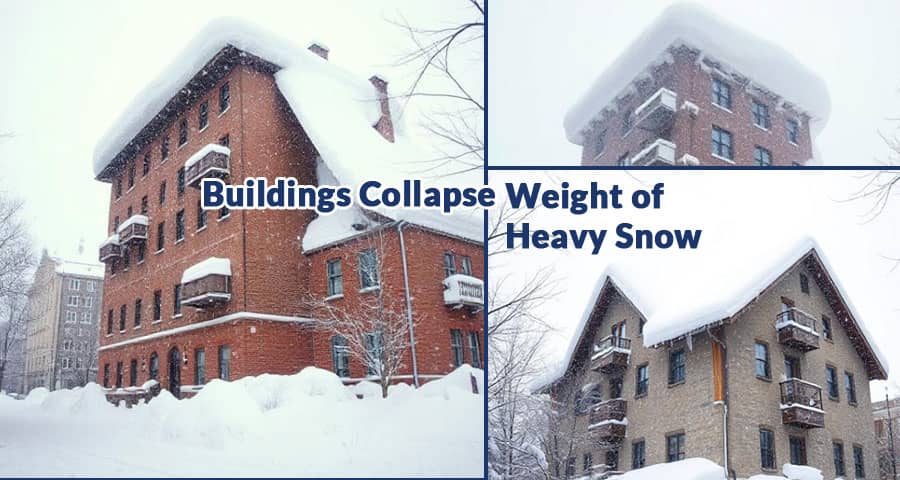Why Do Buildings Collapse Under the Weight of Heavy Snow?

Understanding the Structural Risks of Snow Load
Heavy snow accumulation on roofs can exert tremendous downward pressure, exceeding the designed load-bearing limits of buildings. Snow may appear light and fluffy, but as it compacts and absorbs moisture, it can become densely packed and extremely heavy. A cubic foot of wet snow can weigh over 20 pounds, and that weight adds up fast over large surface areas.
Buildings designed without proper consideration of regional snowfall statistics, snow drift patterns, or structural load tolerances are most vulnerable. Improper or aging roofing materials, insufficient slope, and neglect of regular snow removal further exacerbate the risks, leading to structural failure or even total collapse.
The Science of Snow Load and Structural Engineering
In architectural engineering, snow load is a critical calculation. It refers to the downward force on a building's roof from the weight of accumulated snow. Codes like the International Building Code (IBC) require engineers to assess snow load based on local climate data, roof pitch, exposure, insulation, and thermal conditions.
Flat roofs or those with minimal pitch are at higher risk, as snow accumulates without sliding off. Additionally, roof valleys, parapets, and changes in elevation can cause snow drifts, significantly increasing localized weight. If the live load capacity is exceeded, stress concentrations form, which can deform trusses, warp beams, and eventually cause progressive collapse.
Key Factors That Contribute to Roof Failures
1. Roof Design and Slope
Roofs with steep pitches (more than 30 degrees) are better at shedding snow, while flat or low-slope roofs are prone to accumulation. Commercial buildings with wide spans and flat roofs are especially susceptible if not properly reinforced.
2. Load-Bearing Capacity
Each building is constructed to hold a certain amount of live and dead load. If snow accumulation surpasses the calculated load threshold, structural integrity is compromised. Without adequate safety margins, buildings are vulnerable during blizzards or back-to-back snowstorms.
3. Structural Deterioration
Over time, wooden rafters may rot, metal components corrode, and connections may loosen, all of which decrease the roof's ability to support additional loads. Deferred maintenance, especially in older buildings, significantly increases the risk.
4. Blocked Drainage and Ice Dams
When snow melts and refreezes due to poor insulation or blocked gutters, ice dams form. These prevent proper drainage, adding even more weight and water infiltration, which weakens roof materials and leads to collapse under pressure.
Signs of Imminent Structural Failure
Owners and property managers must watch for warning signs that indicate a roof is under excessive stress:
- Sagging ceiling tiles or beams
- Creaking, popping, or cracking noises
- Visible deformation of roof or walls
- Leaks or water stains during snowmelt
- Jammed doors or windows due to frame warping
These symptoms must be treated as urgent red flags, requiring immediate structural assessment.

Case Studies of Snow-Induced Collapses
Numerous real-world incidents illustrate the devastating effects of snow loads on underprepared structures:
- In 2006, a German skating rink collapsed under snow, killing 15 people. Investigators cited excessive snow accumulation and unnoticed design flaws.
- In Massachusetts (2015), dozens of commercial roofs failed during historic snowfall, highlighting the vulnerability of flat-roofed retail centers.
- The 2010 Connecticut dairy barn collapse caused major livestock losses, emphasizing the economic toll of snow-related building failures in rural areas.
These examples underscore the necessity of engineering for extreme weather events, especially as climate patterns shift and storms intensify.
Prevention Strategies for Snow-Related Building Failures
1. Engineering with Snow Loads in Mind
Designing for snow resilience starts with proper load calculations using regional data and accounting for worst-case snow density scenarios. Engineers must also consider drift loads, especially in buildings with varying elevations.
2. Regular Snow Removal
Roof snow removal is essential, especially after major storms. However, removal must be done carefully to avoid damaging the roofing membrane or causing unbalanced loads. In high-risk zones, trained professionals with safety gear should perform this task.
3. Strengthening Existing Structures
Reinforcing aging buildings by adding bracing, replacing degraded supports, and upgrading insulation reduces the risk of collapse. Retrofitting with snow melt systems or increasing roof pitch can further improve safety.
4. Using Snow Guards and Barriers
For sloped metal roofs, snow guards prevent large sheets of snow from sliding off dangerously and help to control load distribution. In colder regions, these systems are considered essential for both safety and structural integrity.
How Climate Change is Increasing the Risk
Unpredictable winter storms and heavier snowfall events are becoming more frequent due to climate shifts. Warmer air holds more moisture, which can result in heavier, wetter snowfalls - increasing the average snow load even in areas that previously faced minimal risk. This shift demands a re-evaluation of existing building codes and infrastructure resilience.
Legal and Insurance Implications of Building Collapse
A snow-induced collapse can lead to severe legal consequences, especially if negligence is proven in design, maintenance, or response. Insurance claims for snow damage can be denied if owners fail to uphold reasonable care standards, such as timely snow removal or inspections.
Building owners must maintain detailed records of inspections, maintenance, and snow removal efforts to avoid liability and ensure coverage. This is especially crucial for commercial buildings, schools, and municipal structures.
Conclusion: Proactive Measures Save Lives and Assets
Understanding why buildings collapse under the weight of heavy snow is not just an engineering concern - it is a matter of public safety, economic responsibility, and legal accountability. Proactive design, diligent maintenance, and climate-responsive upgrades are the keys to preventing structural disasters.
Let us approach snow events not as unpredictable anomalies, but as predictable load scenarios that demand calculated preparedness.
Please watch the following Short Video for - Why Do Buildings Collapse Under the Weight of Heavy Snow?
